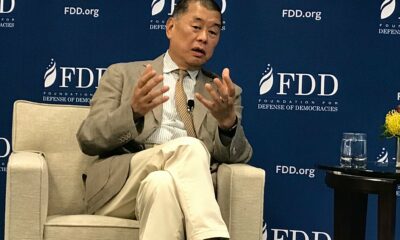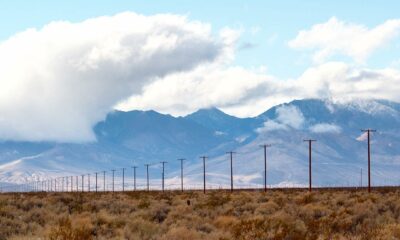Civilization
Global Conflicts Expose Dire U.S. Munitions Shortage
The USA is running out of munitions because we are running out of the rare earth minerals that go to making them.

A Call for Rare Earth Investment
This article is a follow-up to Joe Buccino’s December 23, 2023 Real Clear Defense article “A Shrunken Arsenal: The Alarming Decline of U.S. Munitions”
The United States military is severely short on high-end and artillery munitions at a crucial and strategic moment. As the calendar turns to 2024, Ukraine, using bombs and bullets from the United States, continues its slog of a war with Russia with no foreseeable end. Simultaneously, the U.S. continues sending artillery rounds to Israel amidst the Israel Defense Forces (IDF) assault on Hamas in Gaza. In the Indo-Pacific, American tensions with China remain high as Taiwan prepares for a general election with fears of Chinese interference and Chinese leader Xi Jinping promises the reunification of Taiwan with mainland China. In DC, alarm bells ring regarding the dearth of rounds required for these three distinct kinds of conflict. Central to this issue is an American paucity of rare earth minerals indispensable in producing these bombs, shells, and rockets. To address this shortage and ensure the long-term viability of ammo for high-end conflict, the U.S. must invest in and maintain innovative systems for processing and refinement of rare earth minerals.
An Empty Cupboard: A Paucity of Rare Earth Elements
Rare earth minerals – a set of 17 metallic elements – are the essential materials of bombs, bullets, rockets, and missiles. They are critical in manufacturing powerful magnets used in precision-guided munitions. Some rare earth elements possess temperature stability necessary for some high-tech bombs exposed to intense heat during launch toward target, such as the Javelin missiles so crucial to allowing Ukrainian forces to fend off Russian tanks. Rare earths are in the fuzes of the 155mm artillery shells used in enormous volumes by both the Armed Forces of Ukraine and the IDF. Many air-to-air missiles needed in a fight with China, including the AIM-9X Sidewinder missile, require these materials. Rare earths are used to build actuators for many surface-to-ground rockets.
The rare earth minerals are not particularly rare – these materials are bountiful in the earth’s crust. It is rather the production and refinement capability for the use of these materials – turning these elements into usable material – that is scarce within the U.S. The chemical properties of these materials are nearly identical from one another, making it difficult and costly to separate and refine each one for industrial use. The process also incurs environmental hazards that require expensive cleanup, often making large-scale production economically infeasible.
An American reserve of this material – managed by the U.S. Department of Defense – has been shrinking for decades. Valued at nearly $42 billion in today’s dollars at its 1950s Cold War peak, the U.S. stockpile dwindled to approximately $888 million by 2021. The value continues to drop.
China’s Dominance: A Massive Advantage in Minerals
The depth of the crisis over our mineral insecurity merits concern when compared with China’s position. The People’s Republic of China (PRC) holds approximately 65% of the world’s rare earth minerals. Worse, Beijing dominates the world in processing these minerals with more than 90% of global processing going through the PRC. China’s foresight here is as clear as the United States’ myopia. Should China, in the leadup to an invasion of Taiwan, block exports of rare earths or processing technology, this would cripple the U.S.’s ability to produce the kinds of ammo required to sustain a long-term high-tech war.
Before the 1980s, the United States was the global leader in the rare earths market. Since then, increasing environmental regulations and high labor costs moved much of the production abroad. In the 2000s, China employed a strategic approach to reshape the market dynamics: By flooding the global market with rare earths at lower prices, the PRC monopolized rare earths as both producer and supplier.
This reliance on China and shortage in our own country is of concern beyond the immediate moments. American wars – including those in which both sides employ cutting-edge technology such as World Wars I and II and the Korean War – tend to grow into protracted conflicts, lasting much longer than anticipated. In a war with China, all military services will need to resource deploying and deployed units with munitions for a long war. The U.S. military does not have enough Long Range Anti-Ship Missiles or Joint Air-to-Surface Standoff Missiles required for a sustained conflict with the PLA. Right now, those cupboards are empty. Should the United States find itself amidst a shooting war with China, the defense industrial base does not have a way to domestically refine sufficient rare earth minerals to pump out munitions.
Rather than advancing efforts to boost internal resources, the Biden administration restricts access to mineral-abundant lands in the U.S., impeding potential projects in their early stages, revoking existing leases, and suggesting additional obstacles for mining operations. This approach starkly contrasts with the actions required to strengthen our mineral resource independence.
The extraction of rare earth elements often involves significant land disruption and the use of hazardous chemicals, potentially leading to soil and water pollution. Furthermore, the processing of these minerals can produce toxic waste, posing risks to both ecosystems and local communities. To mitigate these environmental impacts, it is essential to couple any increase in rare earth mining and processing with strict environmental regulations and the adoption of advanced, cleaner technologies. Investments by the U.S. Department of Defense in research for more sustainable extraction methods are also necessary.
Idaho National Lab & U.S. Critical Materials: A High-Tech Pairing
The U.S. must expedite funding for domestic rare earth companies and simplify the permitting process for mining and processing. The federal government must invest in environmentally responsible processing technologies, like those in development at Idaho National Laboratory financed by U.S. Critical Materials. Idaho National Laboratory, run by the U.S. Department of Energy, is on the leading edge of critical materials research and development. U.S. Critical Materials is a private rare-earth exploration and development company based in Salt Lake City, Utah. Just last month, the two organizations joined to develop new rare earth processing technologies. In collaboration, the organizations will develop processes for handling, preparing, mining, and processing minerals critical to producing and employing high-tech military rounds.
Ed Cowle, Executive Chairman of U.S. Critical Materials, told me that pairing with the Idaho National Laboratory offers his organization world-leading engineering and mineral separation technology. The two organizations coordinate to create a fast and environmentally responsible process to build out America’s reserve of rare earth materials using cutting-edge separation technology. James Hedrick, President of U.S. Critical Materials, and former rare earth analyst for the U.S. Geological Survey told me in an email for this article that the rare earth resource and processing will produce high quantities of the strategic elements all critical to American ammunition stockpiles. U.S. Critical Materials will extract rare earths from a deposit it runs in Montana and hand the material to Idaho National Laboratory to develop new, clean refining measures with a goal of keeping the refining process on American shores.
American allies, like Australia and Canada, have established multibillion-dollar and multi-year funding to invest in rare-earth mining. The U.S. must adopt a similar approach, ensuring a steady and secure supply of these critical materials. The global landscape of rare earth mineral production and trade presents a complex web of diplomatic and economic challenges.
Navigating all this while building up its rare mineral reserve requires the U.S. to foster collaborative relationships and trade agreements to establish and enable a diversified and stable supply of these critical materials. The complexity of these international trade networks, coupled with environmental and ethical considerations in mining practices, adds layers of challenges that must be carefully managed. In this global context, the pursuit of rare earth mineral independence for the U.S. is not just a matter of domestic policy, but a complete strategy involving international diplomacy, trade negotiations, and sustainable global practices.
Legislative and strategic initiatives are needed to rebuild and secure the stockpile for the long term. Toward that effort, earlier this year, Congress introduced the bipartisan Rare Earth Magnet Manufacturing Production Tax Credit Act of 2023. If passed, the bill would offer a credit of $20 per kilogram for magnets manufactured in the U.S. This amount could increase to $30 per kilogram for manufacturers who source at least 90% of their components from American suppliers.
Domestic Production: A Long-Term Solution Is Needed
Beyond the current flashpoints in Ukraine and Gaza and the tinder box in the Indo-Pacific, the United States must build an ample reserve of these materials by focusing on minerals produced domestically. For the past eight years, the U.S. Government has invested hundreds of millions of dollars into trying to obtain rare earths from coal ore, and from recycling old motors, computers, and wind turbines. So far no rare earths have been extracted from coal in any substantive, technologically feasible, or economically viable way. Meanwhile, recycling – a laborious, expensive process that is often cost-prohibitive –accounts for only 1% of rare earths produced in America. This leaves physical mining of rare earths as the only viable way to secure and produce domestic rare earths and manufacture the magnets needed for munitions.
The federal government must encourage businesses to develop innovative recycling and production approaches that are cost-effective. For example, the Texas-based Noveon Magnetics streamlines the production process. Instead of mining and converting rare earths into metal alloys, Noveon starts with existing magnets. These are demagnetized, cleaned, and then ground into powder for reformation into new magnets. This technique eliminates the need to separate rare earths, reducing the costs associated with refinement.
Establishing a fully domestic mineral supply chain, stretching from mining operations to the final market, is essential for ensuring security for long-term competition with China. By prioritizing the purchase of minerals sourced and processed within national borders, the U.S. government can both encourage local mineral production and safeguard access to these resources in times of crisis. The 1939 Strategic and Critical Materials Stockpiling Act clearly outlines the dual role of the stockpile: support the industrial base while promoting the growth of domestic mineral production. This act emphasizes the importance of securing and developing U.S. mineral resources to meet the military’s requirement of projectiles.
The current state of rare earth mineral dependency presents a critical concern for America’s national defense. This requires a national strategy that prioritizes investment in new methods of domestic rare earth mineral production and sustainable extraction and processing technologies. Meanwhile, the government must establish resilient international partnerships. Legislative policy must facilitate these endeavors. American elected officials, policymakers, defense officials, and industry leaders must galvanize resources, expertise, and political will towards securing a self-reliant and robust rare earth mineral supply chain. Global security and stability depend on these efforts.
This article was originally published by RealClearDefense and made available via RealClearWire.
Joe Buccino is a research analyst at the Defense Innovation Board, a former communications director at U.S. Central Command, and a retired U.S. Army colonel with five deployments to the Middle East during his military career. He served as the communications director for the NATO support mission in Europe from February to November 2022.
-

 Civilization4 days ago
Civilization4 days agoEqual but Separate: How the Gender Divide Is Rewiring America
-

 Executive3 days ago
Executive3 days agoWaste of the Day: Outlays Per Person Up Nearly 100X Since 1916
-

 Civilization4 days ago
Civilization4 days agoJimmy Lai’s Family Looks to Trump, World Leaders
-

 Executive3 days ago
Executive3 days agoTrump Ditches ‘The Weave,’ Delivers Sales Pitch Susie Wiles Asked For
-

 Executive3 days ago
Executive3 days agoJudge Green-Lights Secret Service Agent’s Retaliation Case
-

 Christianity Today2 days ago
Christianity Today2 days agoYou Must Know His Voice – Powerful Video
-

 Guest Columns2 days ago
Guest Columns2 days agoBlood on the Sand: Australian Massacre Exposes Hollow Core of Anti-Zionism
-

 Civilization1 day ago
Civilization1 day agoTrump National Security Strategy Mirrors Trump World








